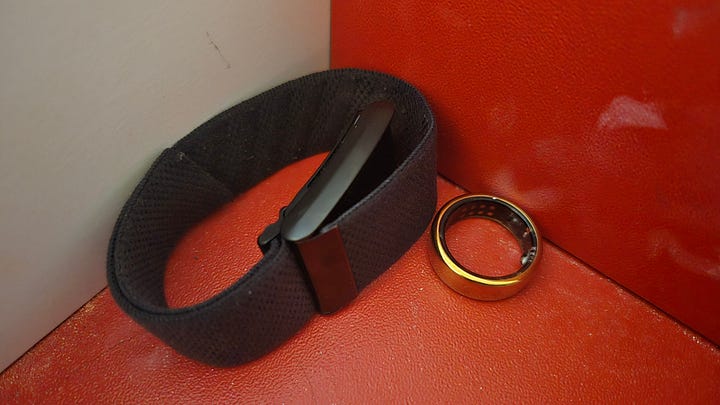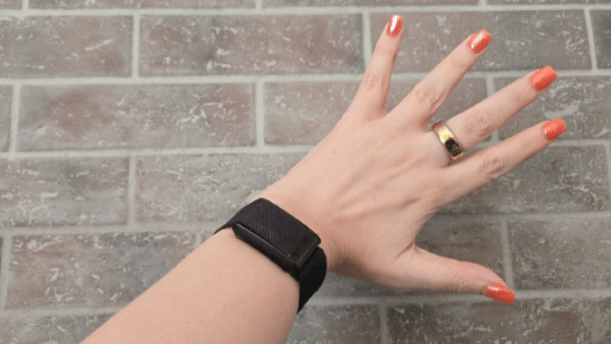I'm Tired of Being Tracked
I ditched my Oura Ring and WHOOP Watch for 28 days and learned a lot about myself, but does that mean I'm breaking up with my wearables for good?
Last February, I was babysitting my niece for a couple of nights at her parents’ house when I realized I had forgotten the chargers for my Oura Ring and my WHOOP Watch. As their batteries slowly drained to zero, I began to panic.
How am I supposed to know how well I slept? How can I calculate the calories I burned giving my niece a piggyback ride? Is my period tracking messed up now? Does anything I do matter at this point?
I relied on these devices to feed me data about my sleep, recovery, and fitness for the better part of 15 months. I wore them religiously and was diligent about keeping them charged.
When I returned home, I immediately charged my wearables, but a question lingered in my mind…
Have I become too dependent on technology telling me how to feel?
Turning into someone I tried not to become
For the last year, I wore my Oura Ring and WHOOP Watch nearly 24/7, only removing them when I showered or had to charge them. I disabled all notifications except for battery life because I didn’t want to be bombarded with reminders.
Still, I checked Oura and WHOOP apps first thing in the morning and throughout the day, especially after workouts. I told myself that I wasn’t obsessed — I turned off the notifications — but I’d get frustrated when my sleep, recovery, or fitness scores weren’t good enough.
My unplanned weekend without wearables left me anxious. I worried the gap in data would affect their accuracy, and I didn’t know how to feel without those magical devices recording my every step and heartbeat.
But I was also relieved. Despite my best efforts to avoid becoming fixated with scores and trends, I still developed a mild obsession with optimizing my wellness. The feedback from my wearables colored my mood more than I realized.
One morning, the Oura Symptom Radar showed a mild strain in my biometrics, even though I woke up with loads of energy. I powered through a very busy day, but felt lethargic after dinner and came down with a cold the following morning.
(Did I will myself sick, or did I ignore a legitimate message from my body telling me to spend the day in bed with a heaping bowl of chicken noodle soup and a queue of YouTube video essays. Chicken-or-egg situation, I guess.)
Some mornings, I felt like death warmed over, yet my readiness and recovery scores declared that I was ready to seize the day. The positive messages were nice to read, even if I didn’t believe them at all.
As a reformed perfectionist and recovering people pleaser, it was inevitable that I’d develop a co-dependent relationship with my wearables, seeking validation that I was living the right way and weighing their feedback more than my instincts.
It was time to challenge that.
The challenge: 28 days without wearables


On May 4, I removed my Oura Ring and WHOOP Watch and placed them in my desk drawer for the remainder of the month.
I had a few goals going into this challenge:
To reset my sleep (I had just returned from a trip, so my schedule was off)
To get up and move, even without a wearable to track my progress
To test my discipline by logging my sleep habits in a journal every day
To not feel (as) attached to my wearables
To help me with those goals, I used Road Trip to Younger’s 4-Week Sleep Reset as the framework for my journal entries. Instead of printing everything out, I drew out all of my pages by hand1.
Each day, I recorded the following:
Wake time & bedtime
Caffeine intake (if any — I don’t consume it often)
Time of my last meal
The time I logged off work
The time I turned all screens off
Notes about how I was feeling
At the end of each week, I reviewed my average sleep time, reflected on what I learned during the week, and set my goals for the week ahead.
Here’s an overview of how I fared during my 4-week sleep reset, sans wearables.
Week 1: Off to a strong start
Focus for the week: Building a consistent sleep routine, limiting my screentime, and not eating after 7 pm.
How it went: I was falling asleep around 11:15 pm and waking up by 7 am every night. I also met my goal of not eating after 7 pm and felt lighter in the morning. To save myself from screentime, I journaled every evening and built a LEGO set. (I’d love to make this a more regular hobby, but I don’t have the space to display my creations!)
What I learned that week: I realized my sweet spot is 7.5 to 8 hours of sleep per night, so I aimed for that going forward. I was also more mindful of how my actions during the day affected how I felt at bedtime. Since I didn’t have a ring or watch feeding me information, I truly had to rely on myself.
Week 2: I could get used to this, but…
Focus for the week: Build upon last week’s progress, log off work by 9 pm.
How it went: I had a couple of very late evenings that week. That Tuesday, I logged off at 11 pm and fell asleep at midnight. Despite that, my average bedtime for the week was 11:11 pm and I was waking up naturally around 6:30 am. Meanwhile, my mealtime window widened slightly to 8 pm, but I wasn’t worse off for it.
What I learned that week: When things go well, I don’t think about my wearables at all, but I was burned out by the end of the week and missed having the Oura and WHOOP telling me what was up. Alas, I had to continue to rely on myself.
Week 3: Ebbs and flows
Focus for the week: Just get by. This was a rough week.
How it went: Although I maintained a consistent sleep schedule, I just did not have much energy. The dreary weather, PMS, and yes, more late work nights drained me. I was catching a few naps here and there, too. To my credit, I did not reach for caffeine; according to my log, I only had it once that week. I should have increased my water intake instead. I was drinking less than two 32oz bottles per day, so I was probably dehydrated, too.
What I learned that week: I’m not going to feel 100 percent all the time, even when following a fairly regular schedule, and that’s fine. There’s nothing wrong with slowing down and letting my body conserve energy. I still accomplished everything I needed to that week without going at a breakneck pace.
Week 4: Crawling to the finish line
Focus for this week: Drink more water, cut back on late nights of working.
How it went: By this point, I was losing all motivation to write in my sleep journal. had just grown tired of tracking everything. On the plus side, my sleep schedule leveled out, and I was back to drinking at least two 32oz bottles of water a day. I found my Classic Kindle and started reading before bed and sometimes in the morning before breakfast2.
What I learned that week: Barring special circumstances, I am capping my workdays at 7 pm from now on. I always considered myself a night owl who was more productive in the evenings, but the truth is I’m that in-between type who thrives best with balance. I truly am a middle child.
What did I achieve from my month without wearables?
Let’s revisit the goals I wanted to accomplish from this challenge…
Did I reset my sleep?
I think so. Despite a few setbacks and some poor planning, I was successful. I have a better understanding of how much rest my body needs to function. I’m also more inclined to wake up naturally than force extra sleep. Most of my issues came down to things I have control over — my habits.
Did I get up and move more often?
Not really. I’ll give myself a failing grade here. I wanted to get outside and walk every day but between bad weather and lame excuses, I didn’t make it happen. Aside from a few home kettlebell workouts, I was too sedentary, which showed in my energy levels.
Did I journal my sleep every day?
Yes, but I started to coast. My notes were a lot less detailed by the final week and I was doing the bare minimum of logging my bedtimes and wake times. It’s not all bad news — this challenge did help me become more attuned to my body.
Do I feel less attached to my wearables?
Yes, but I didn’t arrive at that point right away.
On June 1, I slipped my Oura Ring back on and left my uncharged WHOOP in my drawer. I figured I’d start slowly after 28 days without any digital tracking.
Immediately, I found myself bargaining with Oura’s algorithm. That 30-minute sleep latency you recorded was due to me reading before bed. If my sleep score is going to be less than perfect, it better be for a damn good reason!
When the Oura’s battery died, I left it off for a few days. Eventually, I put it back on… then took it off again. I haven’t worn my Oura Ring in two weeks.
I did return to my WHOOP Watch because I’m exercising regularly. Even then, I’m slow to recharge the battery and I don’t think twice about taking it off before I go to sleep.
RFK Jr. would like every American to wear a smart device to track their health, but I don’t think that’s for me — at least, not all of the time. Going without my wearables for the month reminded me that it’s important to trust myself. The data, while useful, usually adds noise.
Ultimately, I still believe sleep tracking can be helpful, just not always, and not for everyone. I realize I fall into the short-term camp: tracking only when necessary then stepping back once I get what I need.
I have considered wearing my WHOOP during the day for fitness and my Oura Ring at night for sleep, leveraging their respective strengths, but the more I stray from my trackers, the more I realize that digital fatigue is real.
Maybe the right path for me is to go by vibes. And picking up that journal again. Time to stretch out those wrists.
A quick note about how I procured these items
I received an Oura Ring gratis from the brand for a review I wrote for HGTV.com. (In hindsight, I wish I’d executed the story a lot better. A month isn’t long enough to provide a meaningful account of what this device can do. I always hoped to do a follow-up, which I suppose this is.)
WHOOP provided me with a watch for a potential review. I never wrote an official review, but I have shared my thoughts about it here and on LinkedIn. (I’m still paying for the yearly subscription, which just renewed without warning. Oops.)
Like this post? Here’s another story you may want to check out:
The information on this site is for informational and entertainment purposes only and should not be considered medical advice. If you have sleep-related issues or concerns, please consult with your doctor or a qualified healthcare provider.
On the surface, this is me being eco-conscious. In reality, it’s me having a crappy printer.
Do we still consider that screen time? I suppose it’s a grey(scale) area but in any case, it’s been nice to read for pleasure again.







